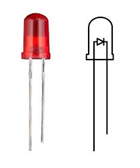TAG: GS 3: SCIENCE AND TECHNOLOGY
THE CONTEXT: The article explains the working mechanism of an LED or the Light Emitting Diode. In 2014, the Nobel Prize for Physics was awarded to three scientists Isamu Akasaki, Hiroshi Amano, and Shuji Nakamura for the invention of efficient blue light-emitting diodes which has enabled bright and energy-saving white light sources.
WHAT ARE DIODES?
Structure
- A diode is an electronic component with two terminals, an anode and a cathode. It allows current to flow in only one direction.
- It consists of a p-n junction, where electrons move easily from the n-type material to the p-type material but not vice versa.
- Semiconductors like silicon and germanium are used to make the most of the diodes.
Functionality
- When a voltage is applied across the diode, electrons flow from the n-side to the p-side, allowing current to pass in one direction.
- It has high resistance on one end and low resistance on the other end.
WHAT ARE LIGHT EMITTING DIODES (LEDs)?
Structure
- An LED is a diode that emits light through a process called electroluminescence.
- Electrons and holes in the p-n junction recombine, releasing energy in the form of visible light.
Band Gap
- The band gap is the energy gap between lower and higher energy levels in a material.
- LEDs are engineered to have a band gap that corresponds to visible light.
Colour Production
- LEDs can produce primary colors (red, green, and blue), allowing the creation of a wide range of colors by combining different LEDs.
- Blue LEDs were developed later due to challenges in creating crystals with the precise properties of gallium nitride, a compound that could yield blue light.
- Breakthroughs in epitaxy, the layer-by-layer building of materials, led to the invention of blue LEDs in the late 1980s.
ADVANTAGES OF LEDs
1. Higher Efficiency: LEDs are more efficient than incandescent bulbs and fluorescent lamps. They can produce 18 times more lumens (visible light emitted per second) per watt of power consumed than incandescent bulb.
2. Durability: LEDs are more durable than traditional lighting sources. A good quality LED bulb can last 3 to 5 times longer than a CFL and 30 times longer than an incandescent bulb.
3. Low Heat: LEDs emit very little heat. In comparison, incandescent bulbs release 90% of their energy as heat and CFLs release about 80% of their energy as heat.
4. Cost Savings: Improvements in LED technology have followed Haitz’s law, leading to a decrease in the cost per unit of light and an increase in light output.
5. Environment friendly: LEDs do not contain mercury or other hazardous substances.
6. Controllable: Brightness and colour of light emitted by LEDs can be controlled.
Haitz’s law: Named for scientist Roland Haitz, it states that for a given frequency of light, the cost per unit of light of an LED will drop 10x (10 times) and the amount of light it produces will increase 20x every decade.
APPLICATIONS OF LEDs
LEDs have diverse applications in industry, consumer electronics, household appliances, and various other fields.
- LED is used as a bulb in the homes and industries
- The light-emitting diodes are used in headlamps and tail lamps of cars and bikes.
- These are used in mobile phones to display the message
- At the traffic light signals leds are used
- They are also used as pointing devices like in led based barcode readers.
FUTURE DEVELOPMENT
- Ongoing research explores more efficient LEDs made of materials like perovskites which have higher colour saturation and higher efficiency.
- Organic LEDs (OLEDs) are a new type of LEDs with superior colour production
- LEDs can be embedded in skin to use body as a display and also as a fashion.

